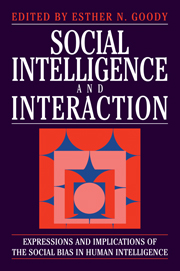 Social Intelligence and Interaction
Social Intelligence and Interaction Book contents
- Frontmatter
- Contents
- List of contributors
- Conventions used in transcripts
- Preface
- Introduction: some implications of a social origin of intelligence
- Part I Primary processes
- Part II The interactive negotiation of meaning in conversation
- 4 On projection
- 5 Interaction sequences and anticipatory interactive planning
- 6 Where does foresight end and hindsight begin?
- Part III Genres as tools that shape interation
- Part IV Expressions of a social bias in intelligence
- Consolidated bibliography
- Index
4 - On projection
Published online by Cambridge University Press: 09 January 2010
- Frontmatter
- Contents
- List of contributors
- Conventions used in transcripts
- Preface
- Introduction: some implications of a social origin of intelligence
- Part I Primary processes
- Part II The interactive negotiation of meaning in conversation
- 4 On projection
- 5 Interaction sequences and anticipatory interactive planning
- 6 Where does foresight end and hindsight begin?
- Part III Genres as tools that shape interation
- Part IV Expressions of a social bias in intelligence
- Consolidated bibliography
- Index
Summary
The topic of this chapter is a varied class of phenomena, most of them small if not tiny, some elaborate and large, which occur in all kinds of visible and audible shapes in all kinds of contexts in human talk and interaction. What is common to all of them is that they occur as prefatory components to bigger things to come. Prefaces range from rather minimal units such as uh, well, or micro-moments of silence, to fully developed pre-sequential utterances such as can I ask you a question? (Schegloff 1980). Gestures also are quite often performed in prefatory slots. The role of prefaces – or pre's (as conversation analysts have fondly nicknamed these pet phenomena) – is to ‘foreshadow’ or ‘project’ (Sacks et al. 1974) something that comes after them, to bring it into play and ‘prepare the scene’ (Schegloff, 1984b). They allow other participants a certain premonition as to what this actor might be up to next.
Vague as it is, this description is not likely to yield a neatly bounded set of phenomena. The collection I describe is eclectic at best. The chapter is loosely organized around a sequence of talk between two nurses from Thailand who discuss weather conditions and proper attire in Germany. This sequence was chosen because it nicely illustrates the theme that runs through all of the examples, namely that interactional units foreshadow one another: moment by moment, the speaker's gestures prefigure the next moment, allowing the participants to negotiate joint courses of action until, finally, a communication problem is solved collaboratively.
- Type
- Chapter
- Information
- Social Intelligence and InteractionExpressions and implications of the social bias in human intelligence, pp. 87 - 110Publisher: Cambridge University PressPrint publication year: 1995
- 51
- Cited by


